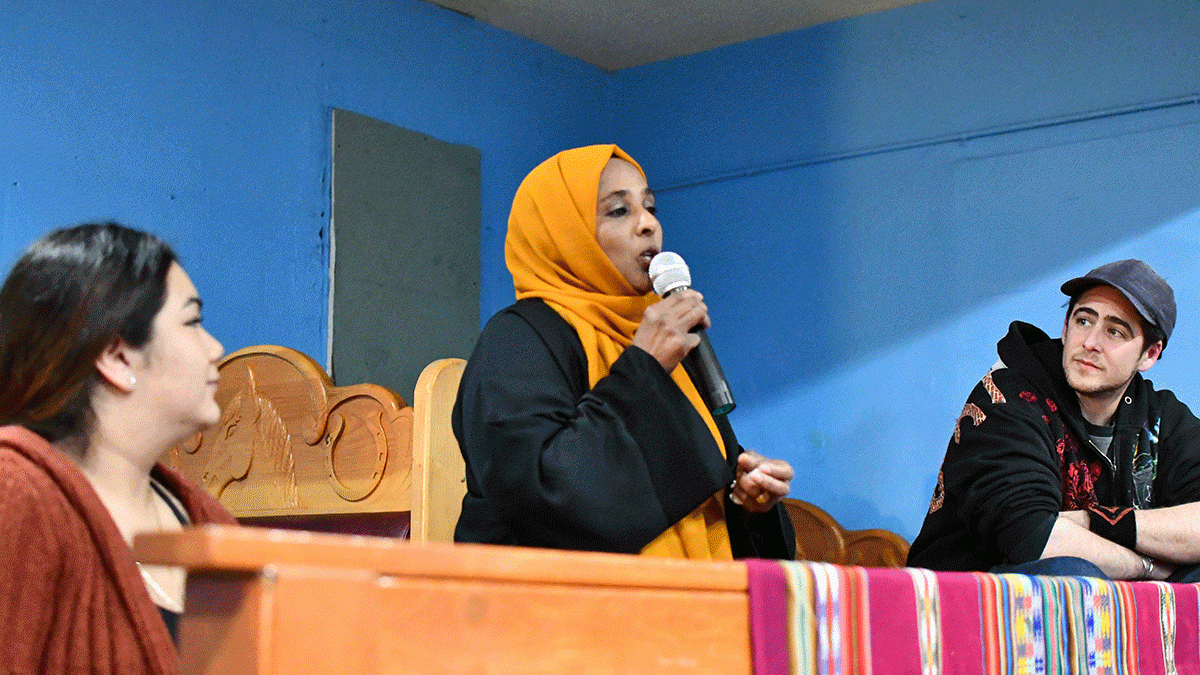
Community member, Muna Hussein, tells her personal experience of poor air quality in the Duwamish Valley.
EDGE co-hosted a Public Health Cafe on air quality that included personal stories from community members.
Taqueria Rincon is a brightly-painted, family-owned Mexican restaurant in South Park, Seattle. On a cold evening in late November, it filled up quickly with more than 40 people there for a community discussion of air quality.
The event kicked off with introductions by Paulina Lopez, Executive Director of the Duwamish River Cleanup Coalition and BJ Cummings, Manager of Community Engagement for the University of Washington Interdisciplinary Center for Exposures, Diseases, Genomics and Environment (EDGE), both co-sponsors of the event. Next, three community members, Maggie Angel Cano, Muna Hussein, and Andrew Shifter, told stories about how their ties to the neighborhoods of South Park and Georgetown compel them to stay in the Duwamish Valley even when they know that it's an area disproportionately polluted by exhaust from road and air traffic and by emissions from local industry.
Cano spoke about how the issue of air pollution hit home for her when her younger siblings suffered from asthma and tachycardia after moving to South Park. Despite their health problems, "moving is not an option," explained Maggie. "We are not willing to leave our friends, families, workplaces, and our schools. We cannot afford to live in another neighborhood."
After the storytellers, Dr. Joel Kaufman, acting director of EDGE, talked about the health effects of air pollution. He introduced the topic with a slide of the Great Smog event in London that killed an estimated 4,000 people in early December of 1952. It was one of the most important events to bring awareness of the links between air quality and human health and to catalyze regulations like the Clean Air Act. Unfortunately, levels of smog seen then are comparable to levels still seen in cities like Dehli and Beijing more than 60 years later. Today the World Health Organization estimates that, globally, 4.2 million people die each year from causes directly related to air pollution. That's more people than are killed by car accidents every year.
Then Dr. Kaufman brought the topic closer to home by talking about the Diesel Exhaust Exposure in the Duwamish Valley study that he helped lead. By tracking a specific marker of diesel exhaust at almost two dozen sampling sites across Seattle, the team was able to create profiles of exposure for different neighborhoods. Georgetown was found to have the highest rates of diesel pollution- more than five times higher than the more affluent Queen Anne neighborhood.
Next, EDGE member, Edmund Seto, spoke about lessons learned from a community-driven air quality monitoring project that he was involved with in Imperial County, California. Imperial County faces threats to air quality from agriculture, traffic, industrial facilities, feedlots and the nearby urban center of Mexicali, Mexico. At the time of the project's inception, there were only five government-operated air quality monitors in the whole county. By the time the study concluded, 40 more had been added, many near schools, playgrounds, nursing homes and other places of importance to the community. At the end of the study, the State of California passed a law to allocate funding for similar work- funding that, in part, will cover the maintenance of the network that the project established.
Seto emphasized lessons learned from the success in Imperial County. These included clearly outlining the purpose for monitoring and the roles and responsibilities of all study partners; understanding the need for rigorous calibration, testing and regular maintenance of air quality monitors; and anticipating the need for additional funds to sustain the network after initial funding has run out.
After the presentations, EDGE scientists fielded questions and comments from community members including Marianne Clark, whose family has been in the Duwamish Valley for five generations and from Lavanya Madhusudan, Outreach and Policy Coordinator for Representative Pramila Jayapal. Also in attendance were Kate Baumgartner, Seattle Director for Senator Patty Murray and John Ryan from KUOW who recorded the event and interviewed storytellers.
Click here for a fact sheet about the health effects of air pollution, created for the event. Click here for a second fact sheet about community-engaged research featuring The Imperial County Community Air Monitoring Project, also created for the event.

